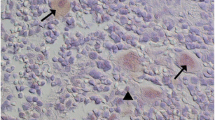Abstract
Following an experiment feeding Deoxynivalenol to growing pigs histological studies have been carried out to evaluate tissue damaging effects of DON. Pigs were fed with naturally contaminated wheat containing 4000 and 6000 µg DON/kg feed. A number of two animals was chosen from control and high exposed group, respectively. Samples of the gastrointestinal tract, liver and kidney were examined. Although, clear effects in feed consumption and weight gain could be realized, only one animal from the high exposed group showed focal alterations in tissues of the gastrointestinal tract.
Zusammenfassung
Im Rahmen eines Fütterungsversuches wurden weiterführende Untersuchungen hinsichtlich einer gewebeschädigenden Wirkung von Deoxynivalenol durchgeführt. Hierzu wurden Schweine mit natürlich kontaminiertem Weizen (4000 und 6000 µg DON/kg Futter) gefüttert. Zu Versuchsende wurden stichprobenartig jeweils zwei Tiere aus Kontroll- und hochbelasteter Gruppe herausgegriffen, deren Magen-Darm-Trakt sowie Leber und Niere histologisch beurteilt. Trotz der hohen Belastung der Tiere sowie deutlicher Effekte in Futteraufnahme und Gewichtsentwicklung ließ sich kein einheitliches Bild über das gewebeschädigende Potential dieses Toxins erstellen.
Similar content being viewed by others
Literaturverzeichnis
Arnold DL, McGiure PF, Nera EA, Karpinski KF, Bickis MG, Zawidzka ZZ, Fernie S, Versonders RF (1986) The toxicity of orally administered deoxynivalenol (vomitoxin) in rats and mice. Fd. Chem. Toxic. 24 (9), 935–941
Rotter BA, Thompson BK, Lessard M, Trenholm HL, Tryphonas H (1994) Influence of low-level exposure toFusarium Mycotoxins on selected immunological and hematological parameters in young swine. Fund. Appl. Toxicol. 23, 117–124
Prelusky DB, Gerdes RG, Underhill LK, Rotter BA, Jui PY, Trenholm HL (1994) Effects of low-level dietary deoxynivalenol on hematological and clinical parameters of the pig. Natural Toxins 2, 97–104
Trenholm HL, Foster BC, Charmley LL, Thompson BK, Hartin KE, Coppock RW, Albassam MA (1994) Effects of feeding diets containingFusarium (naturally) contaminated wheat or pure deoxynivalenol (DON) in growing pigs. Can. J. Anim. Sci., 361–369
Cote LM, Beasley VR, Bratich PM, Swanson SP, Shivaprasad HL, Buck WB (1985) Sex-related reduced weight gains in growing swine fed diets containing deoxynivalenol. J. Anim. Sci. 61(4), 942–50
Pestka JJ, Moorman MA, Warner RL (1989) Dysregulation of IgA production and IgA nephropathy induced by the trichothecene vomitoxin. Fd. Chem. Toxic. 27 (6), 361–368
Dong W, Sell JE, Pestka JJ (1991) Quanititative assessment of mesangial immunglobulin A (IgA) accumulation, elevated circulating IgA immune complexes, and hematuria during vomitoxin-induced IgA nephropathy. Fund. Appl. Toxicol. 17, 197–207
Rasooly L und Pestka JJ (1993) Polyclonal autoreactive IgA increase and mesangial deposition during vomitoxin-induced IgA nephropathy in the BALB/c mouse. Fd. Chem. Toxic. 32 (4), 329–336
Author information
Authors and Affiliations
Rights and permissions
About this article
Cite this article
Dillenburger, T., Lauber, U., Steffl, M. et al. Wirkung von Deoxynivalenol (DON) auf den Magen-Darm-Trakt männlicher Läuferschweine. Mycotox Res 16 (Suppl 2), 162–165 (2000). https://doi.org/10.1007/BF02940027
Issue Date:
DOI: https://doi.org/10.1007/BF02940027




